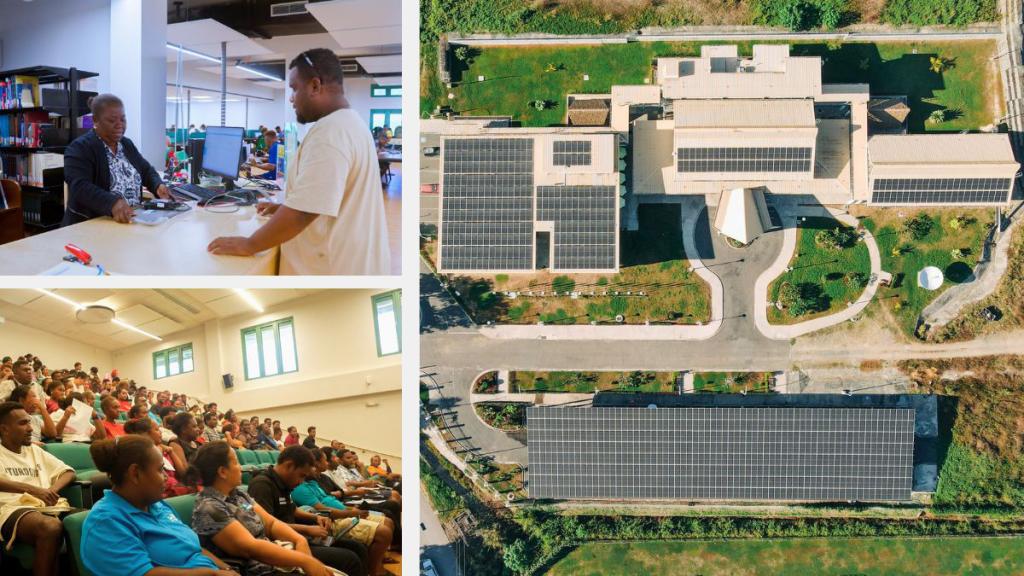The Pacific’s first climate-resilient tertiary campus, powered by solar and built for extreme weather.
· The new campus is boosting female enrolment by providing a safer, more spacious, and inclusive environment.
· ADB, USP, and the Solomon Islands Government delivered a state-of-the-art campus serving over 4,000 students.
University study has an exciting new look in Solomon Islands that is setting a new benchmark for sustainable and inclusive education in the Pacific.
In Honiara, the capital, a striking new facility has just opened its doors. The newly completed University of the South Pacific (USP) Solomon Islands Campus is the first climate-resilient, accessible tertiary campus of its kind in the region.
It will transform the learning environment for thousands of Solomon Islands students, helping to solve the complex challenge of meeting sharply rising demand in the country for quality tertiary education.
Brought to life through a unique partnership between the Solomon Islands Government, the USP Council and the Asian Development Bank (ADB) through its Asian Development Fund (ADF), the project is already delivering life-changing improvements for both students and staff.
For students it has been a big leap forward from the old USP Centre opened in 1971 at what was meant to be a temporary location.
“The old campus was quite small, with limited space,” says final-year commerce student, Alwyn Maesulia, who last year as then president of the student association supported students to transition to the new campus.
“Students used to come in early just to try to secure a place to do their studies,” says Maesulia.
“Moving into the new campus, students are very excited because of the size and state-of-the-art facilities.”
Greener by Design
With over 4,000 students already enrolled, the new campus boasts a large lecture theatre, spacious classrooms, computer and science labs, and a spacious student library.
The campus has been built to high environmental and safety standards with solar energy systems, rainwater harvesting, and natural ventilation, making it a flagship for sustainable, disaster-resilient education.
“We wanted this campus to be green,” says Officer-in-Charge of USP in Solomon Islands Clayton Kuma.
A Safer, More Inclusive Space
The investment is not purely academic. With plenty of clean, separate ablution blocks for male and female students and staff, better lighting, wheelchair-accessible pathways, and 24-hour security, the campus has been designed for safety and inclusion.
Head of Student Administrative Services, Frances Revo, says she has already seen the impact on students of the new open, enhanced facilities.
“Especially with the female students, there is an increase in interest to study here, maybe due to the environment itself. That’s something that makes them feel at ease and comfortable here at the new campus.”
This sense of comfort and safety is echoed by many female students like Natasha Sipele.
“I really like the atmosphere here,” says Sipele, a second-year student completing a double degree in international business marketing and tourism management.
Being on a safe and inclusive campus where everyone is interested in doing their studies has also helped student morale, she says, “At the new campus with all the space and security, my female friends and I feel really, really safe.”
And the numbers support it. Female student registration has risen significantly since the new campus opened in October 2023. Overall, there are now more female students than males enrolled.
“Creating a safe inclusive campus is all part of USP and the Solomon Islands Government’s vision, supported by ADB, to meet the nation’s high demand for tertiary education,” says Kuma.
“We want to encourage young people and professionals to pursue their education. We have excellent courses that can cater for the needs of most people, including this new generation.”
Expanding Opportunities for Learning and Teaching
The expanded facilities mean the university can now offer a wider range of courses, from foundation through to postgraduate including a self-funded Master of Business Administration (MBA) and Doctor of Philosophy (PhD) level studies online.
The transformation has also been profound for the university’s faculty and staff. The Coordinator of Pacific TAFE, Primo Ugulu, who oversees the largest cohort of students on the campus, recalls the challenges they faced in the past.
“We moved four times in six years and at each location, we struggled with the facilities, and inadequate IT that was not conducive to online learning.”
The new campus has changed all that says Ugulu, “Now it’s motivating to come to work in an environment equipped with new facilities, and good internet connectivity. It makes work much easier for all of us.”
Partnering in Pacific Innovation
The new campus is a symbol of partnership, progress, and Pacific innovation. Supported by ADB through its Higher Education in the Pacific Investment Program. This shared vision was brought to life with a $15.4 million concessional loan from ADB through the ADF and a $1.5 million grant from the Clean Energy Fund.
The Solomon Islands Government provided the crucial component of centrally located land and led the implementation of the project through the Ministry of Education and Human Resources Development (MEHRD), while the USP Council was responsible for designing and now operating the campus.
As MEHRD Permanent Secretary Dr. Franco Rodie reflects on the new campus with pride, “What was badly needed was a campus with modern facilities, and that’s what you see now. We achieved everything we set out to do.”
– ADB




